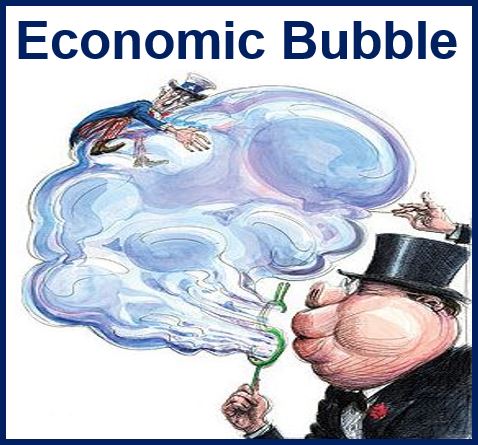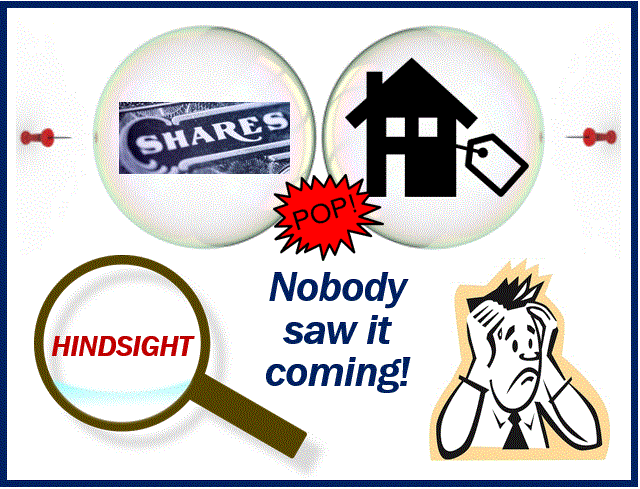What is an economic bubble? Definition and causes
An Economic Bubble, also known as a Market Bubble or Price Bubble, occurs when securities are traded at prices considerably higher than their *intrinsic value, followed by a ‘burst’ or ‘crash’, when prices tumble. The term is commonly used when talking about the property market (housing bubble).
*The intrinsic value of a security is what it is really worth, its actual worth, rather than its market price or book value.
Advancements in digital communication and trading platforms have significantly increased the speed and volume of transactions, potentially accelerating the formation and expansion of economic bubbles.

Boom-bust cycle
Economic bubbles can happen when asset prices are based on implausible views about the future. The term is often used alongside the business cycle, which is also known as a boom-bust cycle.
Bubbles are only identified in retrospect when the price of the asset drops – as it is almost impossible to determine the actual intrinsic value of something in live markets.
When there is an economic bubble, prices constantly change to a point where supply and demand can no longer set the price.

Nasdaq defines an economic bubble as:
“A market phenomenon characterized by surges in asset prices to levels significantly above the fundamental value of that asset. Bubbles are often hard to detect in real time because there is disagreement over the fundamental value of the asset.”
Experts disagree on why bubbles occur
Research suggests that bubbles can happen without any bounded rationality. While other theories suggest they are often caused by price coordination, among other factors.
The economic impact of a bubble has been the subject of debate between different schools of economic thought. Although the general consensus is that they are not beneficial, there are different opinions on just how harmful their formations and bursts are.
Mainstream economists say that bubbles are not able to be identified in advance and cannot be prevented from forming. Given this uncertainty, it is the responsibility of government authorities to wait for bubbles and address the aftermath with monetary policy and fiscal policy.
The Austrian economic school of thought views economic bubbles as having a very bad impact on the economy, because they cause misallocation of resources, thus resulting in non-optimal uses.
Too much liquidity suggested as likely cause
A possible cause of bubbles is excessive monetary liquidity in the financial system, which causes banks to engage in reckless and inappropriate lending standards, which can shake financial markets and lead to volatile asset price inflation – caused by leveraged speculation.
Behavioral finance theories suggest that cognitive biases like herd behavior and overconfidence can contribute to the inflation of economic bubbles, as investors collectively overestimate prospects and underestimate risk.
The former president of Deutsche Bundesbank, Axel A. Weber, said that “the past has shown that an overly generous provision of liquidity in global financial markets in connection with a very low level of interest rates promotes the formation of asset-price bubbles.”
Examples of economic bubbles in history
- Florida speculative building bubble (1926)
- Stock-market bubble of the twenties (1922–1929)
- Poseidon bubble (1970)
- Japanese asset price bubble (1980s)
- 1997 Asian financial crisis (1997)
- The Dot-com bubble (1995–2000)
- Indian property bubble (2005)
- British property bubble (2006)
- Irish property bubble (2006)
- United States housing bubble (2007)
- Spanish property bubble (2006)
- China stock and property bubble (2007)
- Romanian property bubble (2008)
- Uranium bubble of 2007
- Rhodium bubble of 2008
- Australian first home buyer (FHB) property bubble (2009)
Brief history
The term “economic bubble” dates back to 1720. It was first used in relation to the British South Sea bubble, a period of intense speculation that led to a major and catastrophic market crash.
In 1720, the British Parliament passed the ‘Bubble Act’ to control the proliferation of joint-stock companies, requiring them to have a royal charter—a document signed by the king or queen that outlines an organization’s objectives and legal rights.
Economic Bubbles – vocabulary and concepts
There are many compound words in the English language related to “economic bubbles.” Here are six of them, plus their meanings and how they are used in a sentence:
-
Economic Bubble Formation
The process by which an economic bubble begins and asset prices start to rise.
Example: “Analysts are studying the current market trends to understand the economic bubble formation that seems to be taking place.”
-
Economic Bubble Burst
The point at which an economic bubble collapses and asset prices plummet. Example: “Investors fear the economic bubble burst, which could lead to significant financial losses.”
-
Economic Bubble Analysis
The examination and study of the causes, effects, and patterns of economic bubbles.
Example: “Her thesis provided a comprehensive economic bubble analysis of the early 2000s technology sector.”
-
Economic Bubble Risk
The danger or probability of an economic bubble occurring in a market.
Example: “The central bank warned of the increased economic bubble risk due to the overheated real estate market.”
-
Economic Bubble Impact
The effect or aftermath of an economic bubble on the broader economy.
Example: “Policy makers are concerned about the long-term economic bubble impact on retirement savings.”
-
Economic Bubble Dynamics
The complex behaviors and factors that contribute to the growth and collapse of economic bubbles.
Example: “A panel discussion on economic bubble dynamics highlighted speculative trading as a key factor.”
Video – What is an Economic Bubble?
This interesting video, from our sister channel on YouTube – Marketing Business Network, explains what an ‘Economic Bubble’ is using simple and easy-to-understand language and examples.

